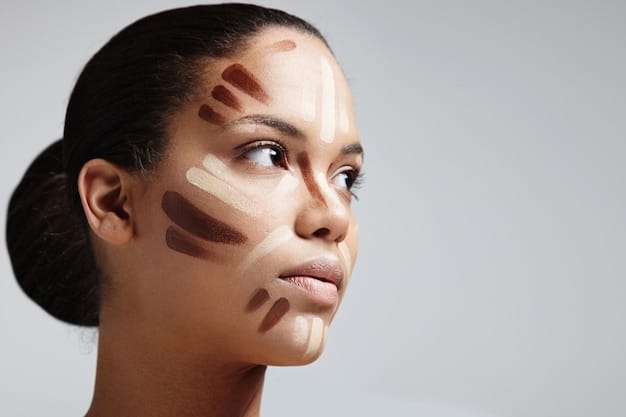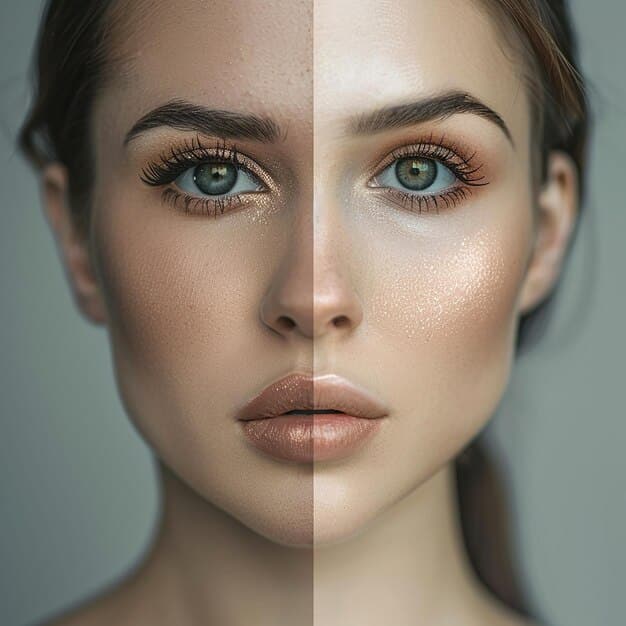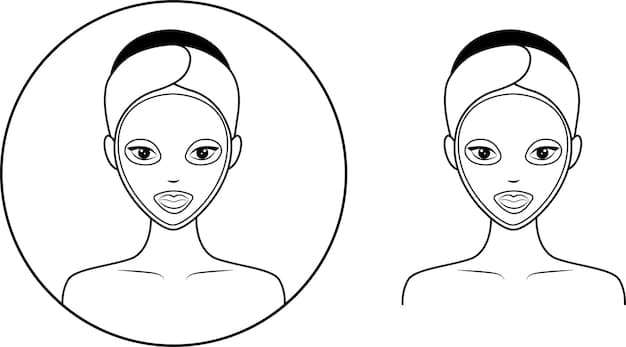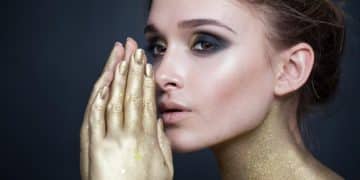Sculpt & Define: Your 2025 Contouring & Highlighting Guide

Sculpt and Define: A 2025 Style Guide to Contouring and Highlighting for Every Face Shape provides expert tips and techniques tailored to enhance your natural features, ensuring a flawless and personalized makeup application that complements your unique bone structure.
Ready to master the art of contouring and highlighting? This Sculpt and Define: A 2025 Style Guide to Contouring and Highlighting for Every Face Shape will teach you the latest techniques to accentuate your best features, no matter your face shape.
Understanding the Basics of Contouring and Highlighting
Contouring and highlighting are essential techniques in makeup artistry, used to define facial features and enhance natural light reflection. They work together to create dimension, adding structure and a sculpted look.
What is Contouring?
Contouring involves using a shade darker than your skin tone to create shadows. This helps to define areas such as the cheekbones, jawline, and nose, giving the face a more sculpted appearance.
What is Highlighting?
Highlighting, on the other hand, uses a shade lighter than your skin tone (often with a shimmer) to bring light to specific areas of the face. Common highlight points include the cheekbones, brow bone, and bridge of the nose.

These techniques have evolved significantly over the years, with new products and methods emerging to suit different skin types and preferences. Understanding the foundations allows for personalized application tailored to individual facial structures.
Areas to contour and highlight can vary based on desired results, but the goal remains consistent: to enhance the natural beauty through strategic shading and illumination.
Here are some guidelines for how to select the perfect products:
- Contour Products: Opt for matte formulas to mimic natural shadows. Cream or powder options are available based on preference and skin type.
- Highlight Products: Choose between shimmer or satin finishes. Consider the undertone (warm, cool, or neutral) to complement your skin.
- Tools: Invest in brushes designed for precise application and blending. Sponges can also be used for cream products.
Proper blending is crucial for a seamless finish, ensuring that the contour and highlight appear natural and not harsh. By mastering these basics, anyone can achieve a professional-looking makeup application.
Determining Your Face Shape: Key to Perfect Contouring
Identifying your face shape is crucial for achieving the most flattering contour and highlight. Different face shapes require different application techniques to enhance their unique features.
Understanding the basic characteristics of each face shape helps to tailor your makeup routine for optimal results. This ensures that the contour and highlight complement your natural bone structure.
Common Face Shapes
There are several common face shapes, each with distinct characteristics:
- Oval: Balanced proportions with a forehead slightly wider than the chin.
- Round: Full cheeks and a similar width and length.
- Square: Strong, angular jawline with a similar width from forehead to jaw.
- Heart: Wider forehead and cheekbones with a narrow, pointed chin.
- Diamond: Wide cheekbones with a narrower forehead and jawline.
- Oblong: Long and narrow, with similar width in forehead, cheeks, and jaw.
To determine your face shape, it’s best to look in the mirror and trace the outline of your face with a lipstick or dry-erase marker. Then, compare the traced shape to the descriptions above.
Consider these simple tips for accurate assessment:
- Take a Photo: A clear photo can make it easier to analyze your face shape.
- Pull Your Hair Back: Ensure your hair is pulled away from your face to reveal the true shape.
- Focus on Proportions: Note the width of your forehead, cheekbones, and jawline in relation to each other.
By accurately identifying your face shape, you can proceed with contouring and highlighting techniques tailored to enhance your specific features. This ensures a balanced, harmonious, and naturally beautiful makeup application.
Contouring and Highlighting for Oval Faces: A Balanced Approach
Oval faces are considered the most balanced shape, making contouring and highlighting relatively straightforward. The goal is to maintain the natural harmony and enhance the existing features.
With an oval face, subtle enhancements can emphasize the cheekbones and add definition without altering the overall proportions.
Contouring Techniques for Oval Faces
For oval faces, apply contour under the cheekbones, starting from the ear and blending towards the center of the cheek. This creates a gentle lift and definition.
Additionally, consider contouring along the temples to add subtle depth to the forehead. A light contour along the jawline can also enhance definition.
Here are some general tips when highlighting faces:
- Cheekbones: Apply highlighter to the high points of the cheekbones, blending towards the temples.
- Brow Bone: A touch of highlighter under the brow bone can lift and open up the eyes.
- Bridge of Nose: A thin line of highlighter down the bridge of the nose can create the illusion of length.
Ensure that all contour and highlight is well-blended for a seamless finish. Use light, feathery strokes and build up the intensity gradually to avoid harsh lines.
When you choose the appropriate products, you can elevate your make-up look:
- Contour Shade: Select a shade that is two to three shades darker than your natural skin tone.
- Highlight Shade: Choose a shade that is one to two shades lighter than your skin tone, with a subtle shimmer.

Oval faces have the flexibility to experiment with various techniques, but the key is to maintain balance and enhance the existing symmetry, resulting in a naturally sculpted appearance.
Contouring and Highlighting for Round Faces: Creating Definition
Round faces benefit from contouring techniques that create the illusion of structure and definition. Strategic contouring helps to slim the face and accentuate the cheekbones.
Highlighting can further enhance these sculpted areas by bringing light to the high points of the face, creating a more defined appearance.
Contouring Techniques for Round Faces
To create definition on a round face, apply contour along the sides of the forehead, temples, and under the cheekbones. This helps to narrow the face and create a more angular look.
Extending the contour along the jawline can also add definition and create the illusion of a more sculpted chin.
Do you have any tips on proper blending?
- Cheekbones: Apply highlighter to the highest points of the cheekbones, blending towards the temples.
- Center of Forehead: A small amount of highlighter in the center of the forehead can add height and dimension.
- Chin: A touch of highlighter on the center of the chin can elongate the face.
Proper blending is crucial for round faces to avoid harsh lines and ensure a natural-looking contour. Use a soft brush or sponge to blend the edges seamlessly.
Here are some general tips on how to avoid common mistakes:
- Contour Intensity: Avoid using a contour shade that is too dark, as it can look unnatural on a round face.
- Highlight Placement: Be mindful of placing highlighter too low on the cheekbones, as it can emphasize the roundness of the face.
By focusing on creating angles and adding dimension through contouring and highlighting, round faces can achieve a more sculpted and defined appearance, enhancing their natural beauty.
Contouring and Highlighting for Square Faces: Softening Edges
Square faces are characterized by a strong, angular jawline and a similar width from forehead to jaw. The goal of contouring and highlighting is to soften these edges and add dimension to the face.
Strategic placement of contour and highlight can create a more rounded and balanced appearance, enhancing the natural beauty of a square face.
Contouring Techniques for Square Faces
To soften the edges of a square face, apply contour to the corners of the forehead and along the jawline. This helps to round out the face and minimize the angularity.
Focus on blending the contour well to avoid harsh lines and create a natural-looking shadow.
Highlighting can elevate the look
Add this to your beauty repertoire. Some tips include:
- Cheekbones: Apply highlighter to the high points of the cheekbones, blending towards the temples.
- Center of Forehead: A small amount of highlighter in the center of the forehead softens the strong forehead shape.
- Center of Chin: A touch of highlighter on the center of the chin balances the lower face.
The key to contouring and highlighting a square face is to focus on creating soft, rounded shapes. Avoid emphasizing the angular features, and instead, aim for a balanced and harmonious look.
When choosing the right tools, consider the following:
- Brushes: Use soft, rounded brushes for blending to avoid harsh lines.
- Products: Opt for cream or liquid formulas for a more seamless and natural finish.
By softening the edges and adding dimension, square faces can achieve a more balanced and flattering appearance through contouring and highlighting.
Advanced Techniques and Tips for 2025
As makeup trends evolve, so do the techniques for contouring and highlighting. In 2025, advanced methods focus on achieving a natural, seamless, and personalized look.
These advanced techniques incorporate new products, tools, and application methods to enhance individual features while maintaining a subtle and refined finish.
Advanced Contouring Techniques
One popular technique involves using color-correcting concealers to contour. This method employs shades like taupe or cool browns to create realistic shadows.
Another trend is using a damp sponge for precise blending, ensuring that the contour seamlessly integrates into the skin.
General tips for product selection
Always consult reviews, but here are some good products to consider:
- Cream Contours: These provide a natural finish that blends effortlessly into the skin.
- Liquid Highlighters: These offer a dewy glow and can be mixed with foundation for an all-over radiance.
These beauty tips can help elevate the process and provide a better overall look. Try these tips:
- Use Setting Spray: This helps to blend everything together and prolongs the appearance.
- Be Gentle: Work in layers versus piling it all on immediately.
Mastering these advanced techniques and tips for 2025 ensures that your contouring and highlighting are not only on-trend but also tailored to your unique facial features. This results in a polished, natural, and effortlessly beautiful makeup application.
| Key Point | Brief Description |
|---|---|
| ✨ Face Shape | Determining your face shape is crucial for perfect contouring and highlighting. |
| 🎨 Contouring | Use darker shades to create shadows, defining cheekbones, jawlines, and noses. |
| 🌟 Highlighting | Apply lighter shades to bring light to cheekbones, brow bones, and the nose bridge. |
| 🔄 Blending | Proper blending ensures a seamless, natural finish, avoiding harsh lines. |
FAQ
▼
To determine your face shape, pull your hair back, look in the mirror, and trace the outline of your face. Compare the shape to common face shape descriptions like oval, round, square, heart, or diamond.
▼
The best products for contouring are matte formulas, either cream or powder, that are two to three shades darker than your natural skin tone. Cream contours are ideal for a natural finish while powders offer buildable coverage.
▼
On an oval face, apply highlighter to the high points of your cheekbones, the brow bone, and lightly down the bridge of your nose. This enhances your features without disrupting the face’s natural balance.
▼
To make a round face look slimmer, apply contour along the sides of your forehead, temples, and under your cheekbones. Extend the contour along the jawline to add definition and create a more angular appearance.
▼
The key to blending effectively is using a soft brush or sponge and light, feathery strokes. Blend the edges seamlessly, building the intensity gradually to avoid harsh lines and ensure a natural, airbrushed finish.
Conclusion
Mastering the art of contouring and highlighting for your specific face shape is an invaluable skill. By understanding the basics, identifying your face shape, practicing targeted techniques, and staying updated with advanced methods, you can enhance your natural beauty and achieve a flawlessly sculpted look.
Read more content





